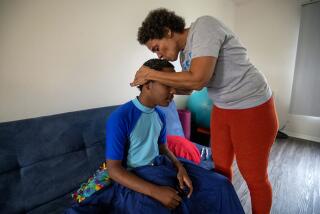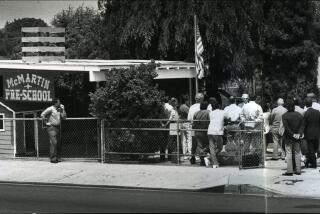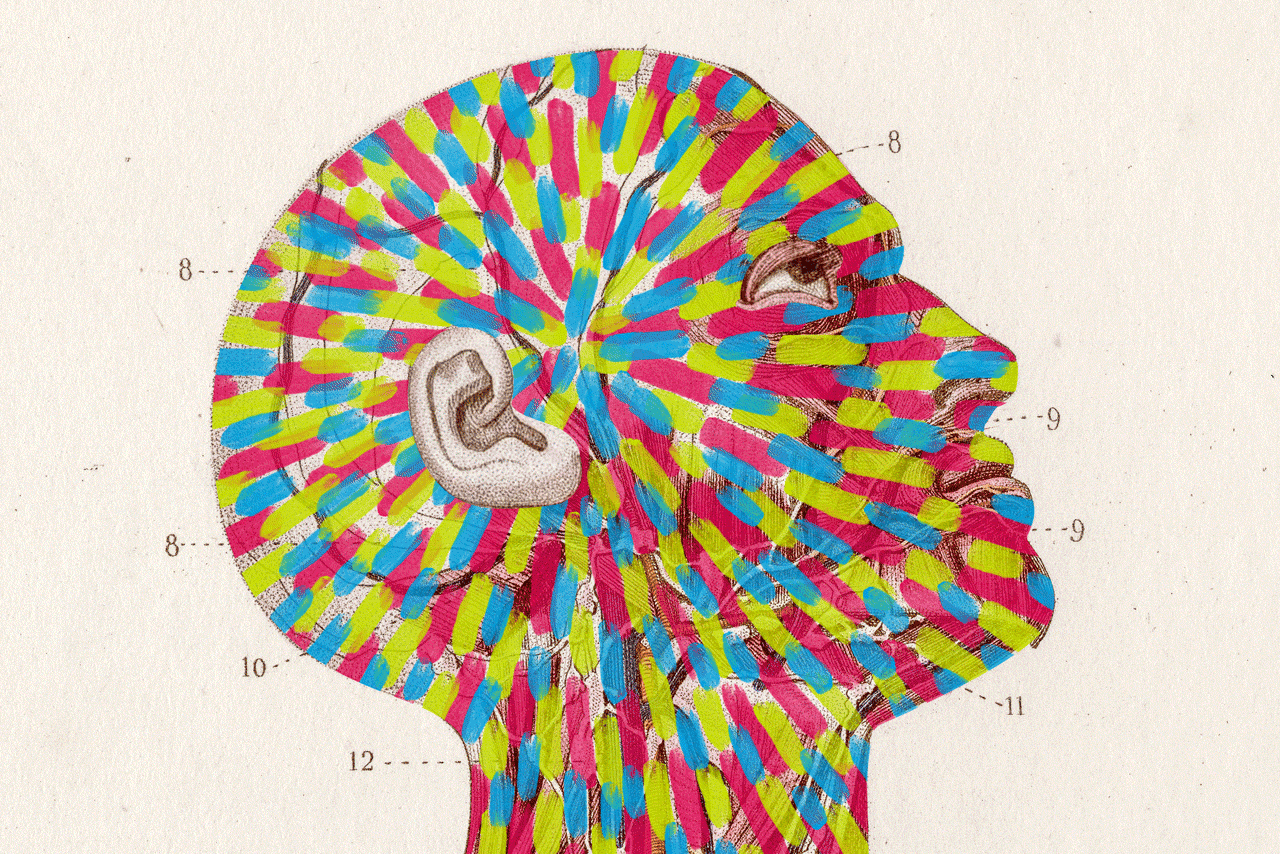Psyche’s Torn Curtain
SANTA CRUZ — He is a big man with a sweep of white hair who lives in a small apartment by the sea, not far from the San Jose hospital where a doctor gouged his brain with a steel wand more than 40 years ago.
The doctor had recommended the operation, and Howard’s parents agreed to it. They thought it was the only way to relieve their 12-year-old son’s “adolescent anxiety,” to subdue his anger, to set his life straight.
It didn’t work out that way. Howard made far more mischief after the operation than he had before. He has struggled with anxiety, fits of anger and moodiness for much of his life. Eventually, he found a kind of peace. Today, at 55, he has a job, a wife who loves him, a sense of humor and a view of Monterey Bay from his easy chair.
Yet the operation still haunts him. He fears that discussing it publicly could jeopardize his job at a transportation company, and with it the small comforts that have taken a lifetime to find. He agreed to be interviewed only if his last name would not be published.
“It horrifies people when I tell them what happened,” he said.
More than half a century after a Portuguese neurologist won the Nobel Prize for inventing the lobotomy, doctors view the procedure as little more than misguided butchery. About 50,000 Americans had the surgery between 1936 and 1960. An estimated several hundred, perhaps several thousand, are still alive.
Silenced for decades by fear or shame, a handful have begun to speak out. Their children and grandchildren are speaking out too, as they struggle to understand the operation’s effects on their own upbringings.
“It’s like we were all supposed to slink into the shadows, as if it never happened, as if doctors never cut into the brains of people we loved,” said Christine Johnson, 34, a medical librarian in Levittown, N.Y. She is writing a book about her late grandmother, who was lobotomized in 1954. Johnson also hosts a website, www.psychosurgery.org, devoted to memorializing people who underwent the procedure.
A new film, “A Hole in One,” offers a fictionalized exploration of the lobotomy era, inspired by a patient’s account. A book-length treatment of the subject by poet Penelope Scambly Schott, based on a relative’s experience, is due out this year.
Some psychiatrists say it is important for the profession to confront this chapter of medical history because doctors today are pursuing increasingly aggressive, brain-altering treatments, from implantable electrodes to powerful drug combinations.
“We as a profession had one generation of humility after the era of lobotomy, but it’s gone,” said Jeffrey Schwartz, a research psychiatrist at UCLA. “We’re now back to a point where the elite of our society believe that the most sophisticated way to treat mental illness is with drugs, magnetic fields, a knife or radiation beam. It’s especially important that we hear the rest of the lobotomy story from people who were there.”
To fathom why lobotomy was once widely accepted, an understanding of the state of mental healthcare half a century ago is required. Overwhelmed by sheer numbers, many mental institutions in the U.S. were chaotic warehouses. Patients screamed in the hallways or lay chained to their beds. Drugs to control hallucinations or quiet imaginary voices were not widely available.
Egas Moniz, a neurologist in Lisbon, had reported in 1935 that he “cured” a paranoid patient by destroying a portion of her prefrontal cortex, behind the forehead. Independently, several leading brain researchers in the United States found that an injury to the prefrontal region subdued aggressive behaviors.
The frontal lobes help primates strategize, solve problems and manage emotions. In a lobotomy, nerve fibers leading to and from the region are severed. Typically, this flattens emotional responses and induces a kind of apathy.
The idea of purposely damaging the brain was appalling to many doctors. Yet the procedure seemed to offer hope to thousands of deeply disturbed men and women who otherwise were likely to remain institutionalized.
Some top psychiatrists and neurosurgeons began performing lobotomies in the late 1930s and found that their patients emerged calmer and easier to manage. Many were able to return home. Soon, news accounts reported that doctors had devised a “surgical cure” for mental illness. By the mid-1940s, lobotomy was viewed as the most advanced treatment psychiatry could offer for severe mental illness. In 1949, Moniz was awarded the Nobel Prize in medicine.
“In the context of that time, control of behavior became paramount, and any treatment that achieved that control was seen as therapeutic,” said Joel Braslow, a UCLA psychiatrist who has written a history of the era, “Mental Ills and Bodily Cures.”
“The illness was being defined by the physician, and the outcome -- whether it succeeded or failed -- was also defined by the physician. The end result was placing the illness only in people’s brains, rather than in the context of their lives.”
*
He has always been a misfit. Among the stepmother’s bill of particulars are lying, stealing, cheating, snooping, scaring, teasing, bullying.... The father, a teacher, admitted his inability to deal with the boy, sometimes beating him and calling him foul names. The boy seemed to bring this on himself.
-- Doctor’s notes on case history No. 6, lobotomized at Doctors General Hospital, San Jose, Dec. 16, 1960.
Twelve-year-old Howard would have challenged any psychiatrist. His mother died of cancer when the boy was 3 years old -- a loss he says he never fully accepted.
After his father remarried, the boy clashed with his stepmother, first over cleaning his room, later over homework, table manners, everything. At Covington Junior High in Los Altos, his grades bottomed out. He was caught breaking into other students’ lockers with a knife. One day, he bolted out of class and into the schoolyard, running around wildly in a downpour.
“I just loved the rain, that’s all,” he recalls. “It was coming down so hard you couldn’t see the ground.”
None of it amused his parents or teachers; the boy was too odd, too angry. “I think my parents were just so frustrated by this point they didn’t know what to do,” he says. “We went to several counselors, several psychiatrists, and then kept seeing more therapists. Until we got to Freeman.”
The late Walter Freeman, who wrote Howard’s case history, had retired from the neurology department at George Washington University in Washington, D.C. By then, he was famous for championing the lobotomy. Freeman was so convinced of the value of the operation that he traveled the country to “treat” just about any stubborn mental problem, charging as little as $25.
He would damage the prefrontal region by driving steel ice picks through each eye socket, just above the eye. This “transorbital” lobotomy required no drilling into the skull, as other techniques did.
Freeman had settled in Los Altos, a few minutes’ drive from where Howard’s family lived. He was nearing the end of his career and would later lose his surgical privileges after one of his patients died on the operating table.
Howard has only dim memories of the operation. His stepmother, who died in 2000, would not discuss it. Nor, Howard says, will his father or his five brothers.
He remembers that his parents drove him to Doctors General Hospital. They told him he was going to get some tests. He recalls getting several shots in the arm. Then the lights went out.
According to Freeman’s report, the lobotomy “was followed by rather severe reaction with fever, stiff neck and vomiting. The patient remained in the hospital five days.”
“All I remember,” says Howard, “is waking up with a massive headache.”
*
Perhaps the most enduring popular image of lobotomy is that of McMurphy, the rebellious mental patient played by Jack Nicholson in the 1975 movie “One Flew Over the Cuckoo’s Nest,” who was reduced by surgery to nodding helplessness.
It’s a misleading picture, according to Donald Stuss, a Canadian neuropsychologist who studied a group of schizophrenics lobotomized in the 1960s. The study lasted more than a decade and included detailed evaluations of 16 American lobotomy patients in an effort to pinpoint the mental changes the operation induced.
Stuss’ research team compared the 16 patients with healthy people and with schizophrenics who had not undergone the procedure. They found that the lobotomized patients functioned well in terms of memory, language and learning.
“That scared the bejeebers out of me,” said Stuss, now director of the Rotman Research Institute in Toronto, which is devoted to the study of the frontal lobes and memory. “We were actually showing real improvements in these areas, compared to the schizophrenics who hadn’t gotten the operation.”
But the study missed larger problems, the scientists later found. Most brain researchers consider the prefrontal region crucial to a person’s ability to act responsibly. It allows people to project into the future, restrain urges and concentrate. The lobotomized patients in Stuss’ study could not focus on a task when there was any distraction.
Childlike, they lost the thread of what they were doing, as if trapped in the moment. Those who lived with lobotomized parents and relatives later described grown men and women who didn’t care for themselves, whose emotions were out of sync with what was going on around them.
It would be years before doctors tallied the cost of the operation in strict medical terms. Early research papers reported that lobotomy was safe, with about 2% of patients dying (an acceptable risk, given the alternative, many thought), and successful as a treatment in 50% to 70% of cases.
In researching his history of the era, Braslow reviewed records of more than 200 men and women lobotomized at Stockton State Hospital, east of San Francisco.
Twelve percent died from the surgery. Only about one in four improved enough after the operation to be released from the hospital.
By the mid-1950s, psychiatrists had antipsychotic drugs, such as chlorpromazine, to subdue schizophrenics, and increasingly viewed lobotomy as extreme and primitive. As quickly as it had appeared, psychosurgery fell from favor.
*
He preferred to be alone on hiking trips, resented being called back to the trail.
-- Doctor’s notes, case history No. 6.
When the headache cleared and he returned home, Howard noticed several changes. He no longer had to go to school, which was wonderful, but odd. His parents seemed to ease up, too, as if they’d become suddenly more tolerant, even doting.
Then one day, his stepmother simply said it out loud: You’ve had a lobotomy.
The word buzzed in the 12-year-old boy’s head -- it always would. At the time, there was no explanation, no discussion. Howard’s teen years were a troubled journey, from Agnews State Hospital in Santa Clara to Rancho Linda, a reform school in San Jose, and on to a series of halfway houses and mental wards. He broke curfews, visiting hours and other rules.
At a halfway house in San Jose, he was caught cashing tax-return checks sent to the institution by mistake. By his mid-20s, Howard had spent several months in jail and been put on probation for forging checks. He got married, then divorced, and meandered between jobs, from tow truck driver to fast-food cook.
“What happened was that any hope of normal life was gone,” he says.
Maybe the lobotomy had ruined his brain; maybe he was using it as an excuse to ruin his life. Of one thing he was certain: He’d been cheated.
“I became a rough kid -- chains, leather gloves, out-of-the-movies type of thing -- and people would stay away from me. I would walk into liquor stores carrying my wife’s purse just to see what happened. There I was, 6-foot-7. No one would say anything. They didn’t dare.”
In time, the boy became a man, aware of what had happened but at a loss as to what to do with the rest of his life. He had no visible scars from the operation, only a lingering suspicion that somehow people knew he was a little “off.”
Was he? He questioned his mental soundness every day, longing for some clue to what the operation had done. “You don’t know who you really are. You’re always asking: Is this me?” he says.
“The fact was, I’d had my brain done. Nobody was going to let me go out and actually be anything -- that’s how I thought about it. I was defective, and no one ever talked about it. No one ever explained what would happen. Would my brain suddenly turn off and I just fall over? No one can tell me that.”
*
After returning home he was relaxed, more cheerful and almost perpetually hungry. It is too early to predict the outcome.
-- Doctor’s concluding notes on Howard.
It may be that Howard’s brain was extraordinarily resilient. Or perhaps it was his youth that saved him. A still-developing brain has a better chance to adapt to a lobotomy-like injury than a fully mature one does, surgeons say.
Or maybe Howard just got lucky, if luck is a word that can be used to describe a life like his.
Three decades after the operation, he began to find the comforts of a settled life. He remarried at age 38. He earned a degree at 44 in computer information systems from a junior college. He found a steady job, working for a vehicle charter firm, where he has won a reputation as a gifted computer programmer and troubleshooter. He’s being considered for a management job.
He is a loyal son who often spends time with his father. He says he bears no grudge against his stepmother. “I’d sit down to dinner with her right now, if it were possible,” he said. “They tried to fix me, and, well, here I am. Why not?”






